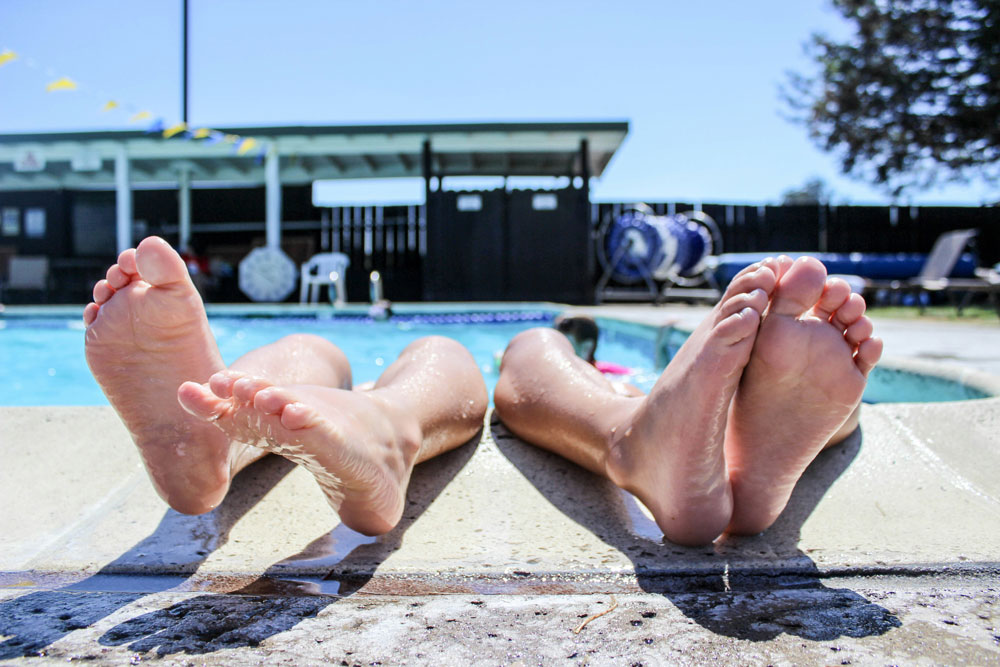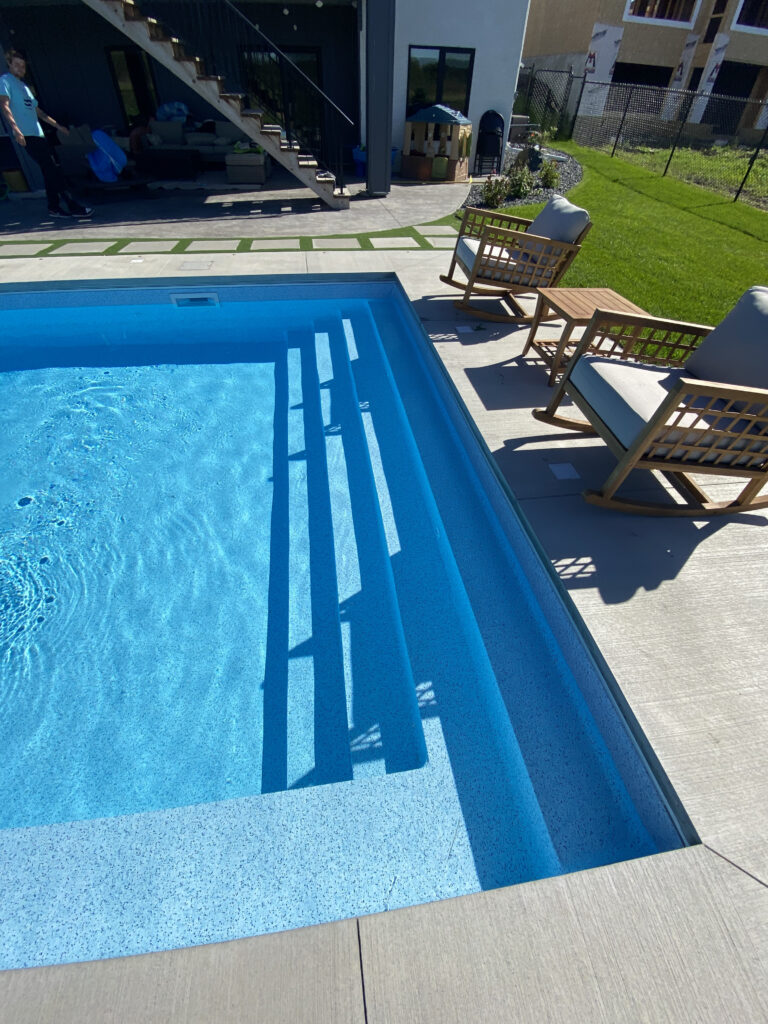Dreaming of a backyard oasis with a sparkling in-ground pool? You’re not alone. Many homeowners share this vision, but the process can seem daunting.

“by Jon Flobrant (https://unsplash.com/@jonflobrant)”
Understanding the installation process is key. It involves more than just digging a hole and filling it with water. There are different types of pools, each with its own benefits and installation requirements.
Choosing the right in-ground pool company is also crucial. They should be experienced, reputable, and able to guide you through the process. They can help you navigate permits, regulations, and even energy-efficient solutions.
This guide aims to demystify the process. It will provide you with the knowledge you need to make informed decisions about your in-ground pool installation. So, let’s dive in and start the journey towards your dream backyard oasis.
Understanding In-Ground Pools: Types and Benefits
When considering in-ground pools, understanding the types and their benefits is vital. Each type offers unique advantages, fitting different needs and preferences.
There are three primary types of in-ground pools: fiberglass, vinyl liner, and concrete. Each has distinct properties affecting durability, maintenance, and customization.
Types of In-Ground Pools:
- Fiberglass Pools: Durable, low maintenance, limited customizability.
- Vinyl Liner Pools: Affordable, customizable shapes, higher maintenance.
- Concrete Pools: Highly customizable, durable, longer installation time.
Choosing between these depends on factors like budget, customization desires, and maintenance willingness.
An informed choice ensures that your pool aligns with your lifestyle and aesthetic goals.
Vinyl Liner Pools
Vinyl liner pools offer versatility in shapes and sizes, catering to custom designs.
While generally more budget-friendly, they require liner replacements every 5-9 years. This adds to long-term costs.
These pools suit homeowners who prioritize initial affordability and design flexibility.
Concrete Pools
Concrete pools provide unparalleled design freedom. They can be shaped into any size or configuration.
Their downside is a lengthy installation period and higher cost. However, their durability and custom possibilities are unmatched.
For those desiring a truly unique pool, concrete is the ideal choice.
The In-Ground Pool Installation Process
Embarking on the installation of an in-ground pool involves several key stages. A well-organized process ensures a smooth experience and a satisfying result.
First, detailed planning sets the groundwork for your project. Selecting the right location, design features, and additional elements is crucial.
Each step, from excavation to finishing touches, requires precision and skilled labor.
Here’s a typical installation process outline:
- Site assessment and excavation
- Pool shell installation
- Plumbing and electrical setup
- Pouring and curing of surrounding concrete
- Final inspections and filling the pool
Understanding this sequence helps in managing expectations. Moreover, it emphasizes the importance of choosing an experienced contractor.

by Anna Demianenko (https://unsplash.com/@annademy)
Choosing the Perfect Location
Location is pivotal for your pool’s success. Consideration of sunlight exposure, existing landscape, and property layout is essential.
Proximity to utilities like water and electricity can influence costs. Strategic placement enhances not just functionality but aesthetic appeal, optimizing enjoyment.
Obtaining Necessary Permits
Pool installation requires adherence to local regulations. It’s crucial to secure the necessary building permits to avoid legal issues.
Consult local authorities or your pool company for specific requirements. Proper documentation ensures compliance, preventing future hassles.
Customization Options
Personalize your pool with various features. Shapes, sizes, and unique elements like waterfalls or lighting can be tailored to your taste.
Consider integrating energy-efficient solutions, like solar heating. Custom options allow you to align your pool with lifestyle and environmental goals.
Selecting the Right In-Ground Pool Company
Choosing the right pool company is integral to your project’s success. A reputable company ensures quality, efficiency, and peace of mind.
To make an informed decision, assess companies based on several criteria.
First, research the company’s reputation in your community. Online reviews and local testimonials are invaluable.
Here’s a checklist for evaluating a pool company:
- Certifications and insurance
- Customer reviews and ratings
- Project portfolio
- Years of industry experience
- Responsiveness and communication skills
Evaluating these factors helps narrow down your choices. A reliable pool company not only handles construction but also offers post-installation support.

by Danist Soh (https://unsplash.com/@danist07)
Certifications and Reviews
Certifications confirm a company’s compliance with industry standards. Look for affiliations with professional associations.
Customer reviews provide insights into service quality and reliability. High ratings and positive feedback usually indicate dependable service.
Portfolio and Experience
Reviewing a company’s portfolio showcases their expertise. Past projects reflect their design capabilities and attention to detail.
Experience translates into smoother processes and better outcomes. A seasoned company can anticipate and resolve potential issues efficiently.
Energy-Efficient Solutions for Your Pool
In-ground pools can be both luxurious and eco-friendly. By integrating energy-efficient features, you reduce costs and lessen environmental impact.
Consider using a combination of smart equipment. Modern technology makes energy savings simple and effective.
Implement these elements for a more sustainable pool:
- High-efficiency pumps
- Solar pool covers
- LED lighting
- Solar or hybrid heating systems
Energy-efficient solutions not only cut energy usage but also enhance pool longevity. Investing in eco-friendly options ensures lasting benefits.
These choices support sustainable living, aligning with broader environmental goals.
by Matthew Henry (https://unsplash.com/@matthewhenry)
Pool Covers and Efficient Pumps
Pool covers conserve heat and reduce evaporation. They also protect your pool from debris, reducing maintenance needs.
Efficient pumps use less energy while maintaining performance. Variable-speed pumps adjust to the pool’s needs, optimizing power use.
Heating Systems and Pool Orientation
Opt for solar heating or hybrid systems to reduce energy costs. They’re environmentally friendly and provide reliable warmth.
The orientation of your pool affects energy use. Positioning your pool for maximum sun exposure maximizes natural heating.
Cost, Financing, and Property Value Considerations
Investing in an in-ground pool involves more than just construction costs. Consider ongoing maintenance and energy expenses. Proper planning helps prevent budget overruns.
Budgeting carefully from the start is crucial. Include unexpected expenses in your calculations to stay on track.
Evaluate financing options that suit your budget and financial goals. This helps ease the financial burden and distributes costs over time.
Keep in mind, a well-designed pool can increase your property’s appeal and value.
- Initial construction costs
- Maintenance and energy expenses
- Potential property value increase
Budgeting for Your Pool Project
Start with a detailed cost assessment for the entire pool project. Factor in materials, labor, permits, and site preparation.
Don’t forget long-term costs like upkeep and potential repairs. Proper budgeting helps you maintain financial stability throughout the process.
Financing Options and Property Value Impact
Explore different financing methods like home equity loans or pool-specific loans. These can make the upfront investment more manageable.
A thoughtfully integrated pool could boost your home’s market value. However, its impact varies based on location and design quality.
Preparing for Your In-Ground Pool Installation
A successful pool installation begins with thorough preparation. First, assess your property for adequate space and optimal layout.
Consider local climate and soil conditions for best results. Addressing these factors will ensure long-term durability and functionality.
Plan for safety features early in the design phase. This includes compliance with local regulations and ensuring family safety.
Your efforts upfront will make the installation process smoother. Proactive preparation sets the stage for a seamless project.
- Assess property for space and layout
- Consider climate and soil conditions
- Plan for safety features

by Joe Pizzio (https://unsplash.com/@pzopro)
Property Preparation and Safety Features
Prepare your property by clearing debris and leveling the ground. A clean, even site ensures a stable foundation for your pool.
Integrate safety features such as fences and alarms into your plan. These elements protect your family and align with local safety codes.
Water Quality and Filtration Systems
Ensure your pool water remains clean and healthy by selecting efficient filtration systems. Consider types like sand, cartridge, or DE filters.
Invest in a water quality management plan from the start. Regular monitoring and maintenance prevent algae growth and enhance swimmer comfort.
Conclusion: Achieving Your Dream Pool
Installing an in-ground pool transforms your backyard into a personal paradise. By understanding the process and making informed decisions, you ensure long-term satisfaction.
Choose a reputable pool company, incorporate energy-efficient features, and prepare your property thoroughly. These steps help create the pool of your dreams.

